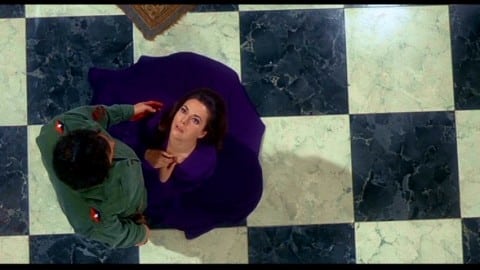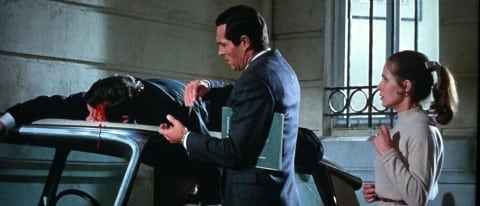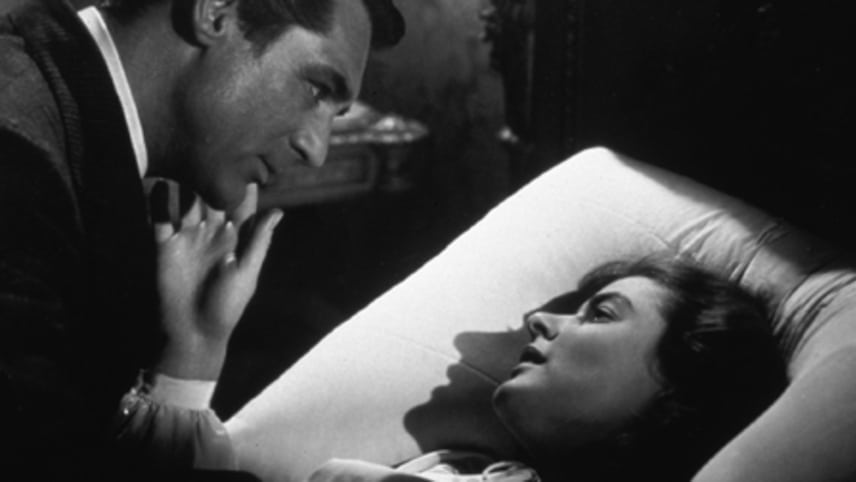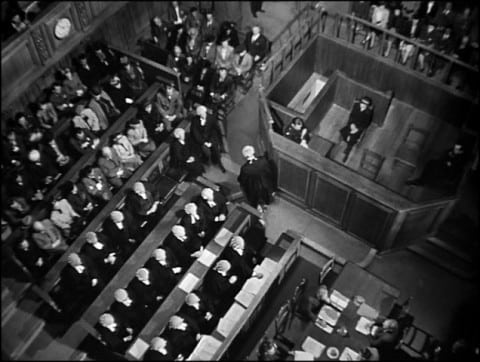Topaz (1969)
Directed by: Alfred Hitchcock
Written by: Leon Uris, Samuel A. Taylor
Starring: Dany Robin, Frederick Stafford, John Vernon, Karin Dor
USA
AVAILABLE ON BLU-RAY AND DVD
RUNNING TIME: 142 min/125 min
THE HITCHCOCK CAMEO: In a crowded LaGuardia International Airport scene, seated in a wheelchair as he is being pushed by a nurse under a sign with an arrow reading “United Airlines – To Planes.” He miraculously stands up from the wheelchair, greets and shakes hands with a man, and walks off to the right
REVIEWED BY: Dr Lenera, Official HCF Critic
SPOILERS
Copenhagen 1962: high-ranking Soviet intelligence officer Boris Kusenov defects to the West with his wife and daughter. CIA agent Mike Nordstrom debriefs him and learns that Russian ballistic missiles with nuclear warheads are to be placed in Cuba. He talks French agent André Devereaux into accompanying his daughter Michèle on her honeymoon with journalist François Picard as a premise to get him to New York City where he entrusts agent Philippe Dubois to get hold of some seriously damaging papers concerning Russian plans in Cuba from the visiting Cuban official Rico Parras. They confirm that the Soviets are secretly transporting and placing missiles in Cuba. Devereaux, ignoring his wife’s fear and accusations of infidelity, sets off to Cuba to find out more details and catch up with his mistress, Parras’s gilrlfriend Juanita de Cordoba….
This is one Hitchcock film I really wasn’t looking forward to watching again, and it’s possible I may have already referred to it as one of his worst. I’d only seen it twice prior to viewing it for this review, and I think both times it almost put me to sleep towards the end, though it’s possible that I was very tired on both occasions. Watching the film properly with a more critical and hopefully more observant eye, one has to conclude that the film is still a misfire but does have its pleasures and sees Hitchcock, if somewhat half-heartedly, continuing the Torn Curtain idea of a more realistic espionage story than normal, this one occurring during and very close to true events. A sprawling, globetrotting spy drama with several sets of characters set against the background of the Cuban Missile Crisis of 1962, it seems both too long and too short in certain places, and goes seriously downhill towards the end, as if the film was shot in sequence and Hitchcock just got bored. The film is undeniably a bit flat and emotionless like Torn Curtain, but every now and again, sometimes virtually coming out of the blue, you get a great scene or shot that reminds you who directed it, while also at the same time saddening you with the obvious fact that he was losing his touch.
Hitchcock had been working on a project called Kaleidoscope since 1962 with various writers. By late 1966 he even had the shots planned for what was to be a very dark psycho thriller about a maniac who kills near water, influenced stylistically by some of the European filmmakers of the time. This would have been the perfect film for Hitchcock to rejuvenate himself and show he was still relevant, but Universal refused it, suggesting Leon Uris’s novel Topaz, which was inspired by the real life Sapphire Affair where Russian agents were discovered to have penetrated French high places, and even had some characters based on real people. Uris adapted his own book, but he and Hitchcock differed on aspects and Uris resented Hitchcock monopolising his time. He hired Arthur Laurents to complete the screenplay, but he left only an unfinished draft. With the shooting schedule rapidly approaching, Vertigo’s Samuel Taylor was hired to start from scratch, and he vastly simplified events and removed characters, but the film began without a completed screenplay and some scenes were filmed just hours after they had been written. Sean Connery and Yves Montand turned down the role of Andre Devereaux and Simon Signoret and Catherine Deneuve that of his wife, Hitchcock again shooting a film without big stars. Preview audiences said the film was too slow, requiring the cutting of 17 minutes, mostly parts of scenes and moments that humanised characters, and mostly from the early and final parts of the film. They also didn’t like the finale, so a second and third ending were shot. The third was used, but didn’t stop the film from becoming a major flop commercially and critically. The second replaced it when the longer version of the film supplanted the shorter one in 1999. I shall discuss these endings later.
Topaz opens with stock footage of a Russian military parade in Moscow’s Red Square over which a rather too jaunty march theme plays over the titles. As we switch to Copenhagen, the same theme plays very quietly for a couple of minutes in what is a really bizarre and annoying use of sound editing. Still, we get a striking opening shot, a complex crane movement up and back down to a window in the Russian Embassy in Copenhagen, taking in a spy in a mirror and then following a defector and his family out of a prison-like gate to the street. Then we get a lengthy sequence where they have to dodge Soviet agents in a pottery and a busy department store, full of furtive looks, people trying to look normal, clever use of angles, as little noise as possible, and two almost heart stopping moment involving the daughter where she drops a vase and almost gets left behind in the streets. This is really good stuff, and helped by the fact they they actually are in Copenhagen. Hitchcock actually got off his arse and shot much of Topaz on location [though Los Angeles doubled for Cuba, and there is some glaringly bad back projection later on]. We then get some debriefing stuff and much chat elsewhere, but it’s not long before we get another great sequence and I really wondered if Topaz was actually really really good and I’d been blind before. In Harlem, Andre gets two other agents to photograph some documents that are in a case belonging to Cuban leader Rico Parras. One of them poses as a journalist to interview Parras while the other tries to take the case. For a while we don’t even go inside the building, the camera remaining outside while we see things happening through the windows and all we hear are street sounds. Climaxing in a totally unexpected jump through a window, this really is Hitchcock working near his best.
Unfortunately, the film never gets that good again apart from the odd arresting image [two dead spies mimicking Mary cradling the body of Jesus as seen in many religious paintings called Pieta] and one astonishing killing where the overhead camera shows the victim’s purple gown spreading in the floor as blood would have spread. We switch to Cuba, and stuff concerning a love triangle and rebels in Cuba, but it doesn’t link much with what had come before, and when we switch again to Paris it feels like we are watching a different movie altogether. The basic plot isn’t actually that complicated, but the excessive chatter when the film should be speeding up towards its climax really works against it – they should have either cut this section to an absolute minimum or expanded it so we actually learnt more detail a la John Le Carre rather than just scratching the surface of this world. There’s even a major section of excitement involving Andre’s son-in-law being kidnapped and escaping from the bad guys – which occurs entirely off-screen! Then again, throughout the script seems to waste time having characters say what has happened in the last scene and what they’re going to do in the next scene. The web of character relationships is unconvincing, with Andre being married, but having an affair with the girlfriend of Rico, while Andre’s own wife is having an affair with….the main French bad guy. It’s hard to care about all this, especially when Frederick Stafford is such a bland lead and the other ‘supposed’ hero Mark Nordstrom virtually does nothing after the opening scenes. Meanwhile something interesting seems to be being done with colours at times, using different colours to enhance aspects of the story, and Hitchcock actually began the project intending to be quite experimental in this respect, but as with some other aspects he obviously just lost interest along the way.
And so….we come to the issue of the ending. The main traitor is exposed at a NATO meeting, and the camera does something very clever – it moves away from him and high above the room, past several chandeliers as the men below bunch into groups, then moves back down to the traitor, and he is asked to leave, as if the camera has judged him. Now you would rightfully expect that we will soon get a thrilling climax, but no, all we get in the current DVD version [which includes the other endings as a Special Feature] is Andre and the villain getting on planes, which is nicely ironic, as the baddie is getting away with it, but leaves one feeling incredibly let down. The ending originally intended for the film had a duel in an empty football stadium, and it’s quite well handled [especially considering Hitchcock didn’t actually shoot it because his wife Alma was ill in hospital], but is seriously out of place and rather silly. The ending used for the cinema release and still remaining in a few versions is an off-screen suicide cobbled together from earlier pieces of footage. It’s dull, but the flashing of images of deaths from earlier in the film does add to add to the bleak irony of its supposed hero having been responsible for the deaths of several people, and overall it makes the most sense. None of these endings is satisfying though, and one could probably easily dream up more interesting or exciting ones.
Apart from John Vernon as Rico and Roscoe Lee Brown’s far too brief appearance as agent Philippe Dubois in the Harlem sequence, the performances tend to be oddly muted [though Karin Dor brings some glamour as Rico and Andre’s girlfriend Juanita] until Michael Piccolo and Phillip Noiret turn up in the French section, Noiret embellishing his role with some fun tics. Maurice Jarre’s score, based largely around a waltz theme which turns up in a variety of guises, even a swirling love theme, often seems too upbeat for the murky goings-ons and mostly sounds like off-kilter Henry Mancini. I was expecting Topaz to be a total bore because that’s what I remembered it to be, and was pleasantly surprised to find that it does have interesting and good things in it, though it’s still basically a failure. It’s a film where its director just doesn’t seem to have had a proper handle on the material, which did have some considerable potential if some major changes had been made. In fact, this is one picture that really could benefit from some serious editing, not so much 17 min [where it seems like it didn’t really help at all] but closer to half an hour, though paradoxically the 142 min version remains overly vague in places and just doesn’t hang together. The film’s a mess, quite frankly, and really gets weaker and weaker after about an hour, which no film should do, but after two or three viewings [that’s if you can be bothered to sit through it again] I do think it improves. Honestly.
Rating: 

















Be the first to comment